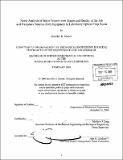Noise analysis of inkjet printers over stages and quality of the job and frequency sources from equipment in laboratory optical trap room
Author(s)
Moore, Jennifer H. (Jennifer Haydon)
DownloadFull printable version (7.251Mb)
Other Contributors
Massachusetts Institute of Technology. Dept. of Mechanical Engineering.
Advisor
Matthew J. Lang.
Terms of use
Metadata
Show full item recordAbstract
This experiment measured the level of sound emitted over the course of the print cycle by an HP inkjet printer and determined how the level varies with changes in the print quality settings and stages of the print cycle. As a test document was printed on the printer at various print quality settings and in two different environments-in a dorm room and in a laboratory chamber, a Sound Level Meter measured the sound intensity over the course of the entire print cycle and recorded the values. While sound levels were similar across some stages of the print job, in the actual printing step, the sound level varied directly with the quality and inversely with the time spent printing. For the normal quality setting, the mean sound level in the dorm room [in the chamber] was 55.242 ± 2.41 dB [56.911 ± 2.12 dB] with 12.4 s [12.4 s] of actual printing. These results have implications for a new generation of inkjet printers. Additionally, this experiment determined the noise contributors to a laboratory room containing an optical trap. The laser's fan-based cooling system yields frequencies of approximately 270 Hz and 540 Hz in the room, while the room's heater produces frequencies of approximately 110 Hz. The devices contributing to frequency peaks are the laser's fan-based cooling system and the room heaters. The fan-based cooling system produced consistent frequencies of approximately 270 Hz and 540 Hz. Also, the room heaters yield a lower frequency output of approximately 110 Hz. Even with all controllable devices turned off, a 33.5 Hz low frequency noise is present in the sound power spectrum FFT graph, most likely from the refrigerator outside the room of interest. To reduce the effect of the electronic equipment's frequencies on the high precision measurements acquired in the optical trap room, data should be taken with the two rooms' heaters off, and a quieter method of cooling the laser should be investigated.
Description
Thesis (S.B.)--Massachusetts Institute of Technology, Dept. of Mechanical Engineering, February 2009. Cataloged from PDF version of thesis. Includes bibliographical references (p. 20).
Date issued
2009Department
Massachusetts Institute of Technology. Department of Mechanical EngineeringPublisher
Massachusetts Institute of Technology
Keywords
Mechanical Engineering.